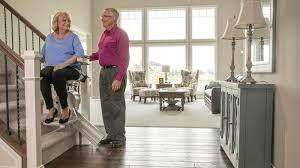
Stair lifts provide a solution for those who need assistance navigating stairs in their homes. A stair lift typically consists of a railing system that is customized to your stairway and a seat.
Keep your home safe by removing tripping hazards like throw rugs, ensuring electrical cords are tucked away, and installing motion-detecting lights to help fool opportunist burglars.
Safety Features
For many people with mobility issues, climbing a flight of stairs can be physically challenging and frustrating. Stair lifts, also known as chair lifts, make it easy to get up and down the stairs without compromising on safety or comfort.
Almost all stair lifts come with safety features that help to keep the user safe. These include swivel seats that enable the user to safely get on and off the lift, safety belts, battery back-up power, and more.
Besides these standard features, some companies offer additional functions that can improve the safety of your loved one while using their stair lift. Some of these are:
Seating
Having a stair lift installed is one of the most effective home modifications for safely and quickly travelling between floors. It’s important to compare your options and choose the right seat for you or your loved one.
Stair lift professionals, like those from Stannah and Bruno, will come to your home to take measurements and walk you through your options. They will provide a detailed estimate, including costs for optional features, and work with you to schedule installation. Straight track stair lifts can be installed within a few days, while curved tracks require a custom build and may take two weeks.
Some stair lifts have rails that fold up, either manually or automatically, to prevent tripping hazards at the bottom of your stairs. You can also find a stair lift that parks its seat at the top of your staircase, away from the doorway. Other safety features include obstruction sensors and retractable seat belts.
Controls
Many stair lift options include controls for the device that can be built into the armrest or a remote control. This can make using the stair lift less complicated, especially for someone with limited dexterity or arthritis in their hands. Other options may involve adding wall-mounted call/send controls on the top and bottom of your staircase. This is more convenient for a family member or caregiver to use and eliminates having to get off the chair to go upstairs or down the stairs to operate the lift.
Lastly, make sure the stairlift you purchase meets all of the safety standards set by the manufacturer and has a battery backup in case of power failure. Most manufacturers will provide a warranty that can range from 2 to 10 years. It’s also important to have an experienced professional complete your installation and assessment to ensure the proper fit of the equipment and electrical power supply for optimal safety.
Financing
When compared to the cost of moving into a nursing home or assisted living facility, stair lifts are an affordable and convenient option to help older adults stay in their own homes. In many cases, a stair lift is also used as a temporary solution while a senior recovers from surgery or an injury.
Many stair lift dealers and manufacturers have a financing program available for those who are unable to pay outright. Many also offer a warranty to provide additional peace of mind.
For those wishing to use Medicare Advantage plans, Medicaid programs or other national and state resources to help fund a stair lift, contacting a local occupational therapist who specializes in home modifications is an excellent place to start. These professionals can perform a comprehensive home assessment and make recommendations for affordable options to help seniors safely navigate the different floors of their homes and reduce their risk for falls. They can also help you navigate the process of obtaining a stair lift and assist in finding the best product for your needs.